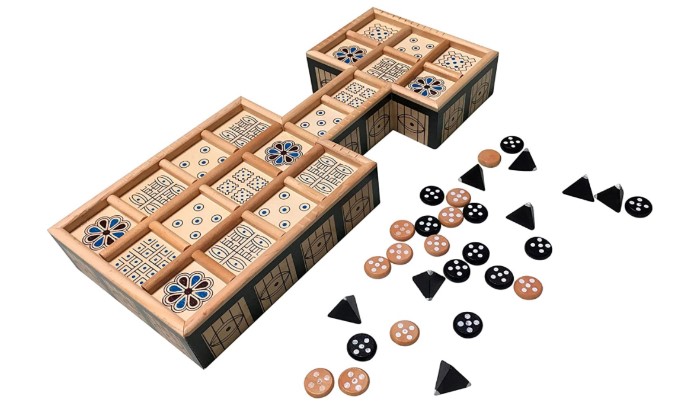
The Royal Game of Ur is one of the oldest known board games. It was first excavated from the Royal Cemetery of Ur by Sir Leonard Woolley around 1926. The ancient Sumerian city-state of Ur, located in ancient Mesopotamia, was a major urban centre on the Euphrates River in what is now southern Iraq. The game is probably a direct ancestor of backgammon. The game also had its gambling version.
More information at: Wikipedia YouTube academia.edu
In 2021, we tested various ways to develop a simple but efficient artificial intelligence at the Faculty of Economics. We prepared two artificial intelligence (AIs) using the multi-criteria assessment of variants. AIs make decisions very quickly, assess the pros and cons of every move using given criteria, and choose the best move. The given criteria are, for example, Shall I enter a new piece? Shall I kick off an opponent’s piece? Shall I play again after that move? Will one of my pieces be threatened?
The semi-lexicographic method is simpler, and we have to order priorities first, and then we check each variant how it meets the given priorities. How shall we choose the right move? We take the most important criterium and check which possible moves meet it. If more moves meet the criterium, we check these moves with the second most important criterium, etc. Finally, we should end up with only one move, which is then exercised.
A more complicated method is the weighted sum method. We do not order the priorities using this method, but we assess them with particular weights, which are positive numbers, reflecting their importance. After computation of much each possible move meets the particular criteria, we calculate the weighted sum to evaluate the move (first criterium*its weight + second criterium*its weight + ... + last criterium*its weight). Mathematically speaking, we perform a dot product of the criteria’s values and their weights. This method is more arduous. However, it is more sensitive and beats the semi-lexicographic method.
Are the created AIs successful? They do not play the game in an optimal way when compared with more sophisticated AIs because they do not observe the future moves as check players do. However, these AIs are clever enough not to make beginners’ mistakes. When testing them, they beat most of the students-testers who won only five games out of eight.
There are questions about what the suitable criteria are, how to order them, and how to assess their weights. This was the objective of our research, and the answers may be found in the paper called Artificial Intelligence Based on MCDM for the Board Game of the Royal Game of Ur issued in the International Journal of Applied Decision Sciences. This paper is not freely available, but please do not hesitate to address the authors if you are interested.
One of the authors presented the paper’s conclusions (in Czech) at the KO-MIX seminar at the Technical University in Liberec. link
If you have any questions, comments, or are interested in further research, do not hesitate to contact the authors (see their e-mails below).